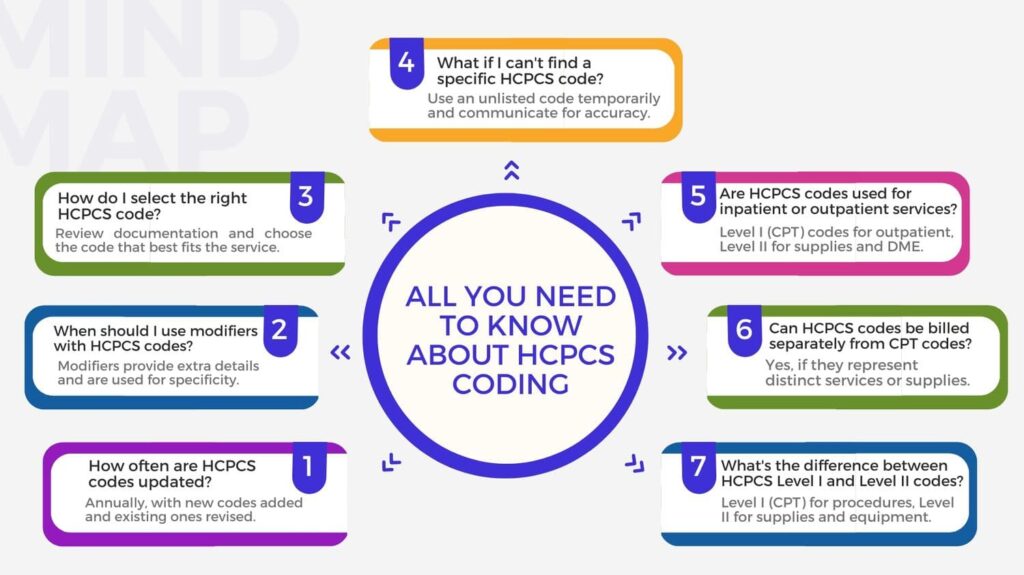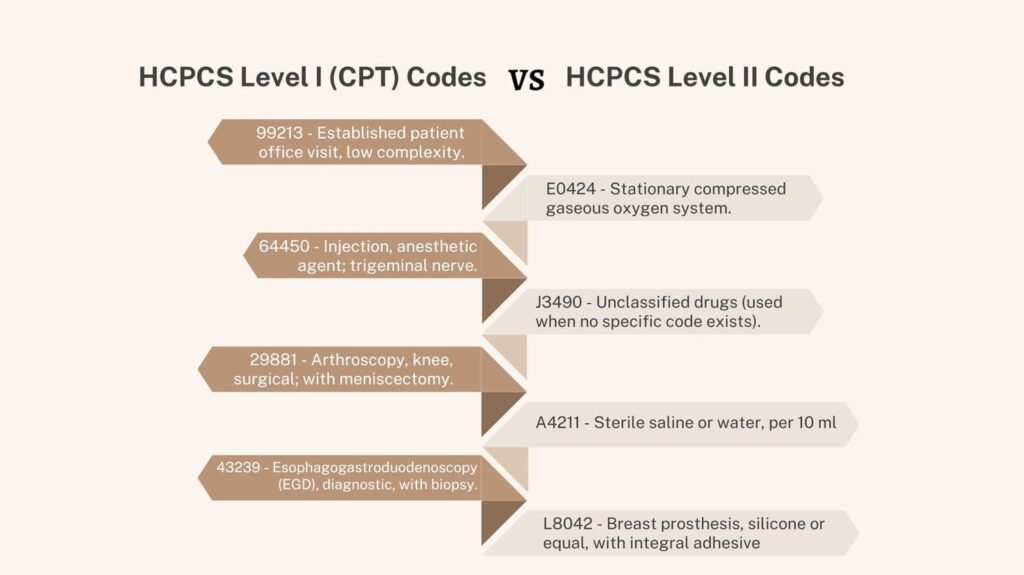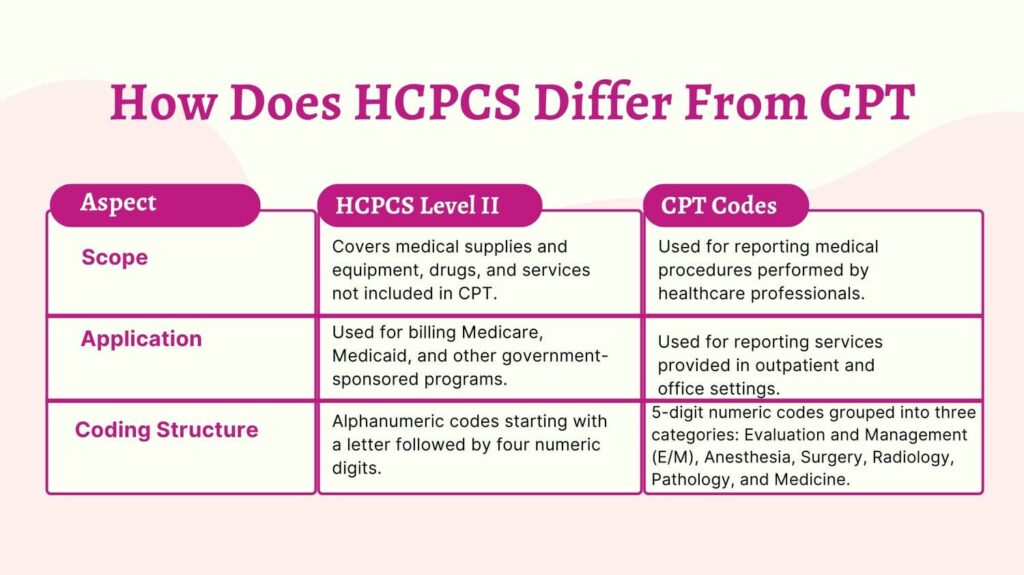If you want to be associated with a medical coding career, then having enough knowledge about the HCPCS coding system is crucial.
As this system enables medical coders to fill out a claim application to send to the insurance companies. With the help of this code, insurance payers of a respective patient identify each medical service, equipment, and supply used by the patient.
So they can pay for the services if covered in the insurance plan.
HCPCS coding system has made it easier to divide hundreds of medical treatments and supplies into simple codes, which as a medical coder you must remember. There are 2 types of codes. Let’s explore both of them.
HCPCS Coding: What Are The Levels?
HCPCS stands for Healthcare Common Procedure Coding System. With the help of the HCPCS coding system or codes, claim applications can be filled and submitted with full accuracy. There are level I and level II HCPCS codes.
HCPCS level I deals with CPT or CPT-4 (Current Procedure Terminology) codes.
This system is under the hands of the American Medical Association (AMA). HCPCS level I codes covers services provided by physicians, laboratories, and outpatient facilities.
Note to remember that it doesn’t deal with health services and items billed by suppliers other than physicians.
HCPCS level II contains codes that are not covered by CPT. Level II of HCPCS is used in a medical bill only for supplies and equipment, used or prescribed during the treatment.
To elaborate further, this type of code classifies ambulances, medical equipment, and commodities.
HCPCS Level 1 Codes

Since medical billing has come into being, other areas related to billing have also originated and keep evolving.
One of these inventions was the introduction of level HCPCS coding, which involves the use of CPT (Current Procedure Terminology) codes. It was introduced in the late 1900s and is currently handled by AMA (American Medical Association).
When we talk about the level I code, we automatically refer to CPT-4. This is the standard significance of HCPCS level I codes and commonly this version is used by health practices.
There has also been an advancement in this code, which is named CPT-5. AMA introduced this new version to healthcare by improving existing ones and removing any errors.
But, this version hasn’t seen its implementation yet.
Level I of the HCPCS coding system consists of 5 digits. These codes are used by medical coders in the bills to help insurance companies determine the health services and procedures taken by the patient.
With the help of this, it becomes easier for them to pay insurance for each service.
Example of HCPCS level 1
As HCPCS level I codes contain 5 numbers, certain numeric combinations classify a specific department of disease.
For example, if code 90716 is mentioned in a hospital bill, it categorizes the department of Varicella or Chicken Pox.
HCPCS Level 2 Codes
Where the level I HCPCS coding system describes what services a patient received, HCPCS level II codes identify what are the supplies used by the patient during treatment.
This coding system is maintained by The Center for Medicare and Medicaid Services (CMS).
Your Journey to Coding Mastery Begins With a Simple Click
HCPCS level II codes are alphanumeric. They do contain 5 digits, but at the start, there is an alphabet (A-V) which is followed by 4 numbers.
Each letter at the beginning of the level II codes defines a certain HCPCS coding chapter, that helps group a similar set of supplies or pieces of equipment.
Additionally, letter from which HCPCS level II codes start signifies each category. I.e. if a code begins with the letter J, it determines non-orally administered medication and chemotherapy drugs.
How HCPCS Level II Codes Are Used
Though the process of defining HCPCS codes in a medical bill is easy, still a procedure is followed to make sure the appropriate classification of patient health services.
As mentioned above, level I codes described what service a patient obtained, these codes are used in the medical bills along with HCPCS level II and ICD-10-CM (describes the necessity of a service).
During the formulation of a bill, if a medical treatment has been identified by a CPT code, coders submit ICD-10–CM codes in order to explain why a specific health service was given to the patient.
Then, HCPCS level I and II codes are added to the claim applications to determine the services and items used during medical treatment.
To further elaborate on how a patient’s health service is described in a medical bill, here are 3 basic codes that are included:
- CPT Code: What medical treatment did a patient receive?
- HCPCS Code: What is the equipment used in the treatment?
- ICD-10-CM: Why did a specific medical treatment given and equipment used by the physician?
Example of HCPCS level 2
As level II of the HCPCS coding system is alphanumeric, there is a specific letter at the start of the code after which there are 4 numeric digits.
For example, code R0070 describes the transportation of X-ray equipment to nursing homes. This code only specifies if transportation served a single patient. For multiple patients, code R0075 will be used by the medical coder.
Dive into The World of CPT Codes
Understanding HCPCS Modifiers
Besides common billing codes, there are other combinations as well that are called modifiers. But what are these?
Modifiers are basically alphanumeric codes that when mentioned with HCPCS, define the medical circumstances further.
So whenever you have to provide extra clarification of any treatment conducted or supplies used, this pair helps as a source to write medical service as a full in the bill.
In terms of HCPCS, modifiers are two-character codes that define the location, time, and other scenarios that are crucial for accurate reimbursement.
Examples of Common HCPCS Modifiers
Modifier 25: Separately identifiable E/M service by the same physician on the same day of the procedure or other service.
Modifier 59: Used to indicate that a procedure was distinct or independent from other services performed on the same day.
Modifier 50: Used to indicate that a procedure was performed on both sides of the body.
Here is a detailed list of common modifiers used during HCPCS coding:
| Modifier | Description | Example of Use |
| -LT | Left side | Procedure performed on the left side of the body |
| -RT | Right side | Procedure performed on the right side of the body |
| -NU | New equipment | Purchase of new durable medical equipment |
| -RR | Rental | Rental of durable medical equipment |
| -GA | Waiver of liability statement issued as required by payer policy | Used when an Advance Beneficiary Notice (ABN) is on file |
| -KX | Requirements specified in the medical policy have been met | Documentation requirements specified by the payer have been met |
| -GY | Item or service is statutorily excluded or does not meet the definition of any Medicare benefit | Services not covered by Medicare |
| -GZ | Item or service expected to be denied as not reasonable and necessary | Used when no Advance Beneficiary Notice (ABN) is on file |
| -XE | Separate encounter | Service performed during a separate encounter |
| -XS | Separate structure | Service performed on a separate organ/structure |
| -XP | Separate practitioner | Service performed by a different practitioner |
| -XU | Unusual non-overlapping service | Service does not overlap usual components of the main service |
| -25 | Significant, separately identifiable evaluation and management service by the same physician on the same day of the procedure or other service | Office visit and procedure on the same day |
| -59 | Distinct procedural service | Identifies procedures not normally reported together but are appropriate under the circumstances |
| -76 | Repeat procedure or service by the same physician or other qualified healthcare professional | Same procedure performed multiple times on the same day |
| -77 | Repeat procedure or service by another physician or other qualified healthcare professional | Same procedure performed by a different provider on the same day |
| -78 | Unplanned return to the operating/procedure room by the same physician following initial procedure for a related procedure during the postoperative period | Return to surgery due to complications |
| -79 | Unrelated procedure or service by the same physician during the postoperative period | Unrelated procedure during postoperative period |
| -80 | Assistant surgeon | Surgical assistant involvement in procedure |
| -81 | Minimum assistant surgeon | Limited surgical assistance |
| -82 | Assistant surgeon (when qualified resident surgeon not available) | Used when a qualified resident is unavailable |
| -AS | Physician assistant, nurse practitioner, or clinical nurse specialist services for assistant at surgery | Non-physician provider assisting in surgery |
| -GC | Service performed in part by a resident under the direction of a teaching physician | Teaching physician oversight in services |
Types of HCPCS Modifiers
During HCPCS coding, 2 types of modifiers are used.
Informational Modifiers: These modifiers are only used to convey additional treatment information to the payer, thus it doesn’t impact reimbursement.
Pricing Modifiers: These codes indicate that medical service has been altered in some ways. It shows that any extra procedure is conducted or any prescribed service is reduced after analyzing the complexity of the case.
HCPCS vs CPT Codes: Which One Should You Choose?

Though both codes represent different purposes in medical billing, still they show some resemblance and might confuse medical coders.
In order to make your claim approved, you must know when to use HCPCS and what is the appropriate point of using CPT in a bill.
It is worth noting that where the HCPCS level II code has been in use most commonly, it is yet not accepted by many insurance payers.
However, whenever you prepare a claim application, you must verify the equipment coverage with the payer to avoid claim denial. Have a look at these coding errors and solutions to avoid them:
| Error | Description | How to Avoid |
| Incorrect code selection | Choosing the wrong code for the service provided | Use coding manuals and resources, verify with physician documentation |
| Missing modifiers | Not including modifiers that clarify specific details about a service | Understand modifier usage guidelines, ensure complete documentation |
| Bundling errors | Coding for services already included in another code | Be aware of bundling rules, verify if services are separately billable |
| Unreported services | Failing to code for all services performed | Review physician notes thoroughly, ensure all procedures are captured |
| Typos and inconsistencies | Entering incorrect code numbers or inconsistencies between codes | Double-check coding accuracy, implement internal auditing procedures |
In some cases, both levels I and level II of HCPCS coding systems coincide with one another, i.e. a code may represent the same type of service in both of these levels. So what would you choose?
Medicare, in such cases, advises using the HCPCS level II code in the medical bill rather than level I.
Conclusion
With the help of our descriptive guide, you will now be able to better understand the HCPCS coding system, how it works, and what its implementation is.
You can now kickstart your journey toward medical coding if this coding system has been under your interest.

